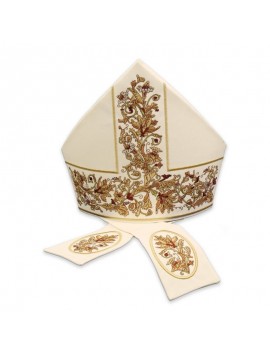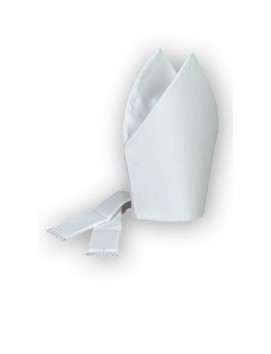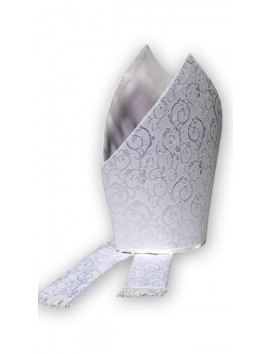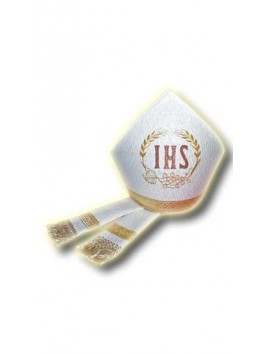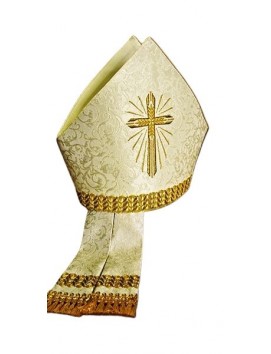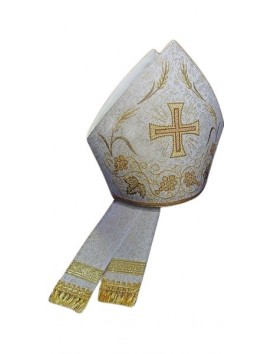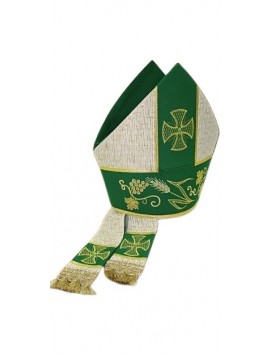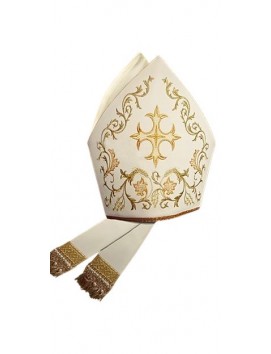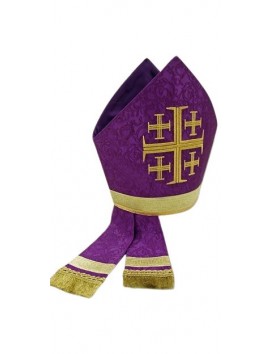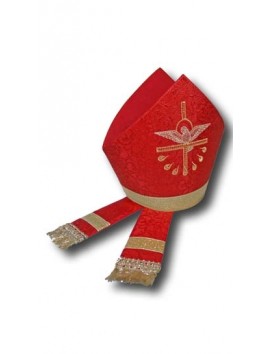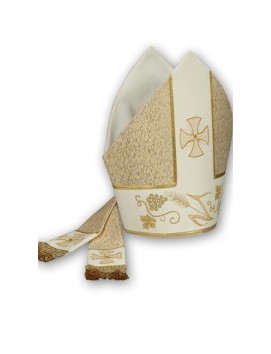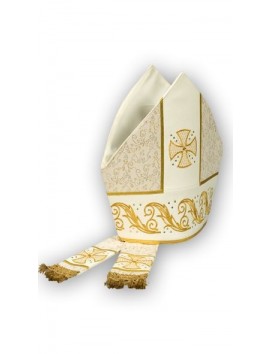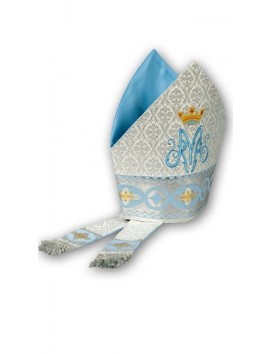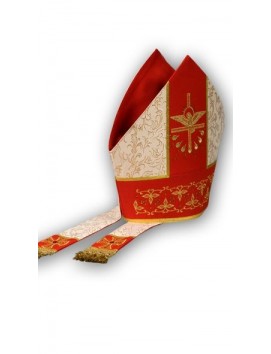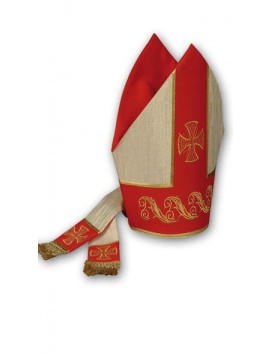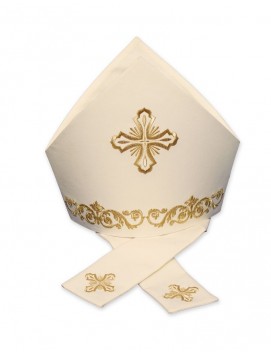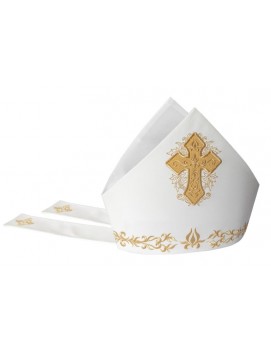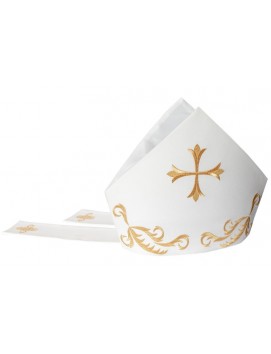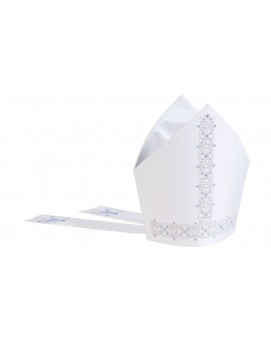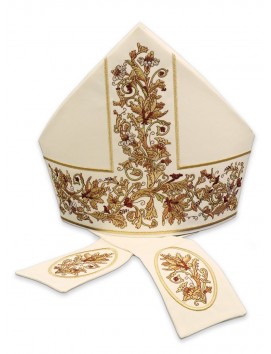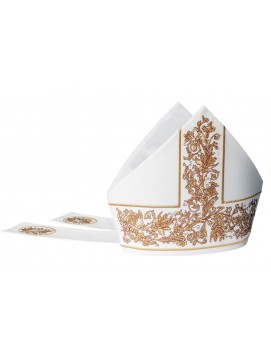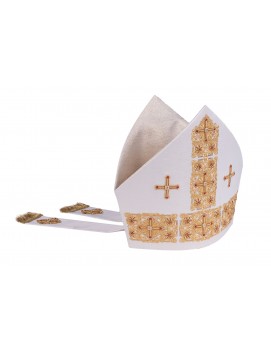No products
Mitres
A clergy mitre is a type of headgear worn by high-ranking clergy members, such as bishops, abbots, and cardinals, in various Christian denominations, including Roman Catholic, Anglican, and some Lutheran churches. The mitre is a tall folding cap, consisting of two similar parts rising to a peak and sewn together at the sides. It is made of various materials, such as silk, linen, or gold cloth, and is often decorated with intricate embroidery or precious stones. The mitre is an important part of Catholic liturgical garments, representing the status and veneration bestowed upon its wearers. The design of mitres dates back to the 5th century CE, with intricate detailing that can vary according to the specific rank of the wearer in the Church hierarchy. The mitre is worn during special liturgical celebrations, such as general councils, solemn pontifical acts of the pope, and other important ceremonies. The right to wear the mitre belongs by law only to the pope, the cardinals, and the bishops, while others require a special papal privilege. The mitre is a symbol of the spiritual authority of the clergy member who wears it. Mitres can be purchased from various online retailers, and can be custom-made to fit the clergy member's style and preferences.
A clergy mitre is a type of headgear worn by high-ranking clergy members, such as bishops, abbots, and cardinals, in various Christian denominations, including Roman Catholic, Anglican, and some Lutheran churches. The mitre is a tall folding cap, consisting of two similar parts rising to a peak and sewn together at the sides. It is made of various materials, such as silk, linen, or gold cloth, and is often decorated with intricate embroidery or precious stones. The mitre is an important part of Catholic liturgical garments, representing the status and veneration bestowed upon its wearers. The design of mitres dates back to the 5th century CE, with intricate detailing that can vary according to the specific rank of the wearer in the Church hierarchy. The mitre is worn during special liturgical celebrations, such as general councils, solemn pontifical acts of the pope, and other important ceremonies. The right to wear the mitre belongs by law only to the pope, the cardinals, and the bishops, while others require a special papal privilege. The mitre is a symbol of the spiritual authority of the clergy member who wears it. Mitres can be purchased from various online retailers, and can be custom-made to fit the clergy member's style and preferences.
The clergy mitre, also spelled miter, is a distinctive piece of liturgical embroidery headgear worn by bishops and certain abbots within various Christian denominations, including the Roman Catholic, Anglican, and some Lutheran churches. This ceremonial headdress is steeped in history and symbolism, representing the authority and spiritual leadership of those who wear it.
Origin and Development
The mitre's origins can be traced back to ancient head coverings. The word "mitre" comes from the Greek μίτρα, meaning 'headband' or 'turban'. Initially, it may have been a non-liturgical accessory worn by the Pope during solemn processions, evolving from a cloth band used in ancient Greece. The mitre as we know it today began to take shape in the 12th century and was adopted by bishops after the 10th century.
Symbolism
The mitre is rich in symbolism. It is said to represent the tongues of fire that rested on the apostles at Pentecost. The two shield-shaped stiffened halves that face the front and back are often interpreted as symbolizing the Old and New Testaments, while the two lappets hanging from the back remind the wearer to keep both the spirit and letter of the Bible. The mitre is also seen as a symbol of the episcopate, an enduring office instituted by Christ himself.
Types of Mitres
There are three types of mitres worn in the Roman Catholic Church: the simplex, auriphrygiata, and pretiosa. The simplex is made of undecorated white linen or silk, the auriphrygiata of plain gold cloth or white silk with embroidered bands, and the pretiosa is decorated with precious stones and gold. These different types are worn for various liturgical seasons and occasions, reflecting the solemnity of the event.
Usage
The mitre is worn during special liturgical celebrations, such as general councils, solemn pontifical acts of the pope, and other important ceremonies. It is typically worn by bishops in procession and when pronouncing episcopal blessings but is removed during prayer, including the eucharistic canon.
FAQs
Who wears the clergy mitre?
The right to wear the mitre belongs by law only to the pope, the cardinals, and the bishops. Others, such as certain abbots and archpriests, may wear it by special papal privilege.
What does the clergy mitre symbolize?
The mitre symbolizes the spiritual authority of the clergy member who wears it. It also represents the splendor of holiness, the dignity of the bishop, and the dual role of the bishop as a successor to the apostles and a shepherd of the flock.
When is the mitre worn?
The mitre is worn during six moments of the Mass: the entrance procession, proclamation of the readings (not the Gospel), homily, administration of the Sacrament, final blessing, and farewell procession.
Can the mitre be purchased?
Yes, mitres can be purchased from various online retailers and can be custom-made to fit the clergy member's style and preferences.
In conclusion, the clergy mitre is a significant and symbolic vestment that denotes the high office and spiritual leadership of bishops and other high-ranking clergy members within the Christian church. Its design and use during liturgical functions underscore the reverence and tradition that continue to be integral to the practice of faith across denominations.

